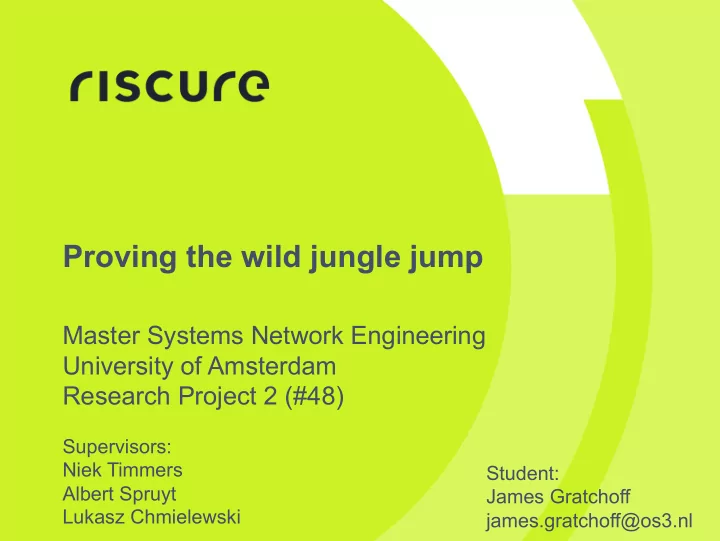

Proving the wild jungle jump Master Systems Network Engineering University of Amsterdam Research Project 2 (#48) Supervisors: Niek Timmers Student: Albert Spruyt James Gratchoff Lukasz Chmielewski james.gratchoff@os3.nl
What is a wild jungle jump? 2
What is a wild jungle jump? The effect of corrupting the program counter of the processor in such a way that it points the attacker to a controlled address Purpose o Run arbitrary code on a secure device Why? o Riscure saw this behaviour happening while attacking systems implementing secure boot 3
Outline I. Introduction II. Scope III. Research question IV. Related work V. Target overview VI. Approach VII. Set up VIII. Assumptions IX. Results X. Conclusions and future work 4
Introduction Research performed at Riscure in Delft o Specialised in side channel analysis and fault injection FI is a successful and cheap way to attack systems: o Cryptographic systems (AES, RSA) o Smartcards Fault injection o Clock o Temperature o Optical (Light) o Electromagnetic radiation o Power Electromagnetic FI 5
Scope Power fault injection o Insert an impulse or drop of power in the system to change the behaviour of the processor without interupting its process Targeting one kind of architecture o ARM 6
Research questions What is the feasibility of a wild jungle jump? o How can the PC be corrupted? o What is the likelihood of a glitch corrupting the PC? o What are the repercussions of a wild jungle jump? 7
Related work o No research perfomed around PC corruption with FI o 2012 Barenghi et al: Fault injection attacks on cryptographic devices? o Memory instructions are the only instructions prone to power FI. o 2014 Thessalonikefs: EMFI on a Wandboard o Skip instructions 8
Target Wandboard o Freescale IMX6 platform with an ARM Cortex A9 processor o RISC infrastructure o 792 MHz (1,26 ns/cycle) o 32-bit This processor is also present in: 9
Cortex A9 overview Register architecture o 37 registers separated in 7 different banks • User bank: General purpose registers Bank specific Stack Pointer, Link Register, Program Counter Shared by all banks: Define the next instruction to Program Status Register execute 10
Approach • Hands on tool to perform FI • Assumptions about how to corrupt the PC • Code implementation (assembly) • Power FI test with wide parameters • Result analysis • Narrow parameters raise percentage of success 11
Set up Set of hardware provided by Riscure o VC glitcher: Glitch generator o Glitch Amplifier o Picoscope 5203: Digital oscilloscope for monitoring o Wandboard Set of software o Picoscope 6.0: Oscilloscope software o Inspector FI 4.8.3: Define FI parameters o FI GraphIt 1.0: Result analysis tool 12
Set up (2) 13
Set up (3) 14
Assumptions To corrupt the PC a glitch could: 1. Skip one or more instructions 2. Corrupt an instruction Code goals: o Prove the feasibility of these assumptions 15
Results- Instruction skip characterization Target: Set of instructions incrementing a counter Goal: Characterization of such attack vector Results: o Counter returned lower values than loop length o Difference in number of instructions skipped observed Success Rate: 45% 16
Results- Instruction skip (2) Target: End and start of consecutive functions Goal: Glue functions together o Value of the registers set in the first reused in the second functions Results: Success Success Rate: 0,01% Remark: Exploitable code could not be found in open source implementation investigated 17
Results – Instruction corruption characterization (MOV) Target: MOV instruction i.e. MOV R1, R2 Goal: Flip the destination register (12-15 bit ) to 1 Result: Success! Attack vector: Arbitrary code execution Success Rate: 0,16% Remark: Instruction often present but not 18 controllable by the attacker
Results – Instruction corruption (LDR) Target: Load instruction Goal: Flip the destination register to PC Attack vector: Memcopy Result: Success! o Code execution by copying an address pointing to the start of the attacker’s code Success Rate: 3,4 % Remark: Present in U-boot 19
Conclusions Wild jungle jump is feasible with power FI o By skipping instruction o Corrupting a MOV or LDR instruction Attack is possible in existing implementation o Memcopy Downsides o Dependencies to reproduce the attack: • compiler version or chain • Need of deep understanding of assembly code o Finding the right FI parameters can be a tedious job 20
Future work • Prove the possibility of a wild jungle jump in other architectures (x86, AMD) • Find other open source real life example of where a wild jungle jump can occur • Perform a wild jungle jump using other FI techniques 21
References: ¡ EMFI ¡picture ¡ h.ps://www.riscure.com/ ¡ ¡ Fault ¡injec:on ¡a.acks ¡on ¡cryptographic ¡devices: ¡Theory, ¡prac:ce, ¡and ¡ countermeasures. ¡Barenghi, ¡Breveglieri, ¡Koren, ¡Naccache. ¡2012 ¡ ARM ¡logo: ¡ h.ps://commons.wikimedia.org/wiki/File:ARM_logo.svg ¡ Wandboard: ¡ h.p://www.wandboard.org/ ¡ I-‑phone ¡4S, ¡Ipad2, ¡Samsung ¡GS ¡III: ¡ h.ps://wikipedia.org ¡ ARM ¡instruc:on ¡decoding: ¡ +h.p://emucode.blogspot.nl/2010/09/decoding-‑arm-‑instruc:on-‑set.html ¡ Electro ¡Magne:c ¡Fault ¡Injec:on ¡Characteriza:on. ¡George ¡Thessalonikefs ¡2014 ¡
Thank you for your attention Questions?
Recommend
More recommend